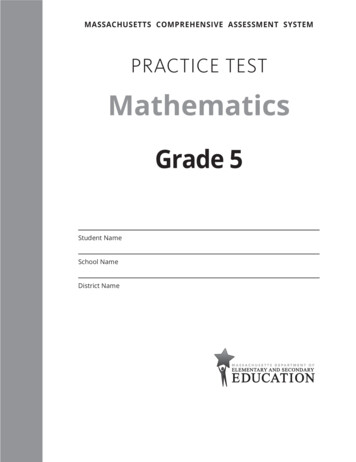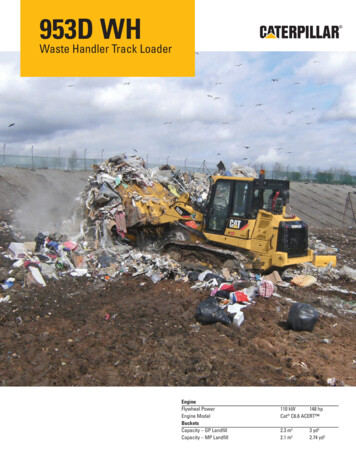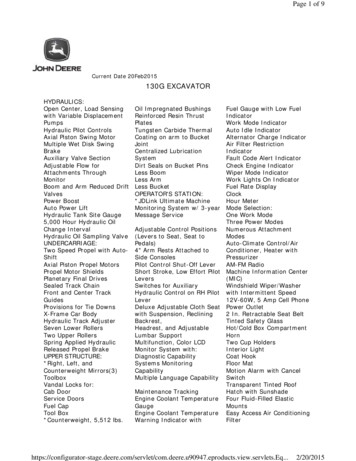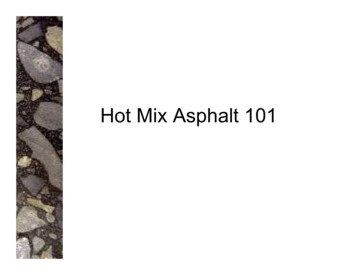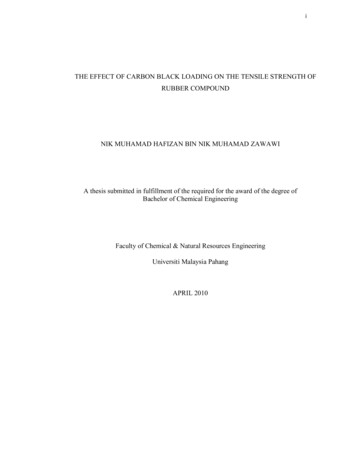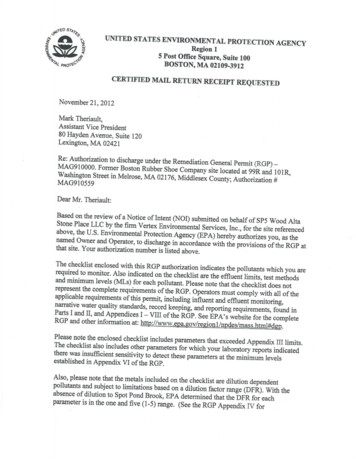
Transcription
VERTEX Vertex Environmental Services, Inc.Vertex Environmental Insurance Services, Inc.Vertex Construction Services, Inc.Vertex International ServicesVertex Air Quality Services, LLCVertex Ingenieros Consultores, S. de R.L. de C.V.Corporate Headquarters400 Libbey ParkwayWeymouth, MA 02189www.vertexeng.comp: 781.952.6000f: 781.335.3543November 12, 2012Mr. Victor AlvarezUnited States EPA5 Post Office Square, Suite 100Mail Code OEP06-4Boston, MA 02109-3912Attn: Remediation General Permit NOI ProcessingRE:FMR Boston Rubber Shoe CompanyCulvert at 99R and 101R Washington StreetMelrose, MassachusettsRTN 3-30758Dear Mr. Alvarez,Vertex Environmental Services, Inc. (VERTEX) is pleased to present this Notice of Intent (NOI) fora Remediation General Permit (RGP) on behalf of SP5 Wood Alta Stone Place LLC (the Owner) atthe property identified as FMR Boston Rubber Shoe Company located at 99R and 101RWashington Street in Melrose, Middlesex County, Massachusetts (the Property). A site locus map isprovided in Figure 1. The NOI is provided in Appendix A.General Facility/Site InformationDuring redevelopment of the Property as multi-family housing, a 380-foot long underground culvert(the Culvert) was identified along the eastern portion of the Property. A plan of the Propertyshowing the location of the Culvert is provided in Figure 2. The culvert contains approximately twofeet of particulate matter (solids that appear to have accumulated in the culvert over time) andseveral feet of standing water. Several samples of the particulate matter were collected in December2011 to assess disposal options. Analytical results from samples of particulate matter indicateconcentrations of various compounds exceeding applicable Massachusetts Contingency Plan (MCP)S-1 reportable concentrations (RCs). Concentrations of various volatile organic compounds(VOCs), semivolatile organic compounds (SVOCs), polychlorinated biphenyls (PCBs), and metalswere detected above MCP RCS-1 criteria. Based on the RCS-1 exceedances, the Owner notifiedthe Massachusetts Department of Environmental Protection (MassDEP) of the 120-day reportingcondition on April 20, 2012, and MassDEP assigned RTN 3-30758 to the release.To achieve a condition of No Significant Risk under the MCP, remediation of the Culvert is beingconducted in accordance with a Remedial Action Measure (RAM). In addition, the remediation is
being conducted as described in a PCB Risk-Based Remedial Action Plan (RAP) that was approvedby EPA Region 1. The proposed remediation plan is to remove all the solids within the Culvert anddispose off site. To facilitate the removal of the solids, VERTEX proposes to collect and treat waterthat is removed from the Culvert prior to discharge to a nearby drainage swale under an RGP.Discharge and Receiving Waters InformationAs shown in Figure 3, the receiving water for the treated discharge is Spot Pond Brook, via asurface drainage swale. According to the MassDEP Division of Water Pollution Control, Spot PondBrook is classified as Class B. The seven day-ten year low flow (7Q10) of the receiving water wastaken from NPDES Permit MAG910511, dated December 13, 2011, which was previouslyauthorized for discharge at the site into the same drainage swale. The 7Q10 flow was determined tobe 0.32 cubic feet per second (cfs) with a 71% prediction error. This number was used to calculatethe dilution factor (DF) as follows:DF (Qd Qs)/Qd (0.223 0.32)/0.223 2.43Where:Qd 100 gal/min x 0.00223 0.223 cfsQs 0.32 cfsContaminant InformationTwo samples were collected within the Culvert area by VERTEX on October 31, 2012 andsubmitted to Alpha Analytical of Westborough, Massachusetts for the analysis of parametersrequired for the RGP NOI. A copy of the laboratory report is provided in Appendix B.To complete Section 3b of the NOI Form, the following table is presented to compare maximuminfluent metals concentrations to Appendix III Effluent Limits (Step 1). Metals that exceedAppendix III Effluent Limits are highlighted and then compared to the Appendix IV Metal Limits,which are calculated by multiplying the Appendix III Limit multiplied by the dilution factor (Step2).MetalAntimonyArsenicCadmiumChromium IIIChromium endixIII /lMax. (2)145,1882,5002DF2.43AppendixIV Limit13.61Influent Conc. .432.432.92161.82,430YYY
Based on the above table, untreated influent samples exceed RGP effluent discharge limits for thefollowing metals: antimony, cadmium, copper, lead, nickel, silver, zinc, and iron.Treatment System InformationA schematic diagram of the proposed water treatment system is provided in Figure 4. Theconstruction dewatering pump will be set to minimize pumping of solids into the initial settling/weirtank. Water treatment, at a minimum, will include bag filters and two 2,000-lb granular activatedcarbon vessels connected in series. Treated water will be stored in four 21,000-gallon frac tanks toprovide adequate storage prior to discharge. Frac tanks and dewatering system will be equippedwith required fixtures, freeze protection, floats, switches, and alarms to continuously operate thedewatering system.ESA and NHPA EligibilityAs demonstrated in the NOI for NPDES Permit MAG910511 dated December 13, 2011, which waspreviously authorized for discharge at the site into the same drainage swale, no endangered species,designated critical habitat, or national historic places were identified in proximity to the proposeddischarge.ClosingA copy of this NOI is being submitted concurrently to the City of Melrose Department of PublicWorks. If you have any questions or concerns, please contact Frank Calandra at (781) 952-6000.Sincerely,Vertex Environmental Services, Inc.Frank Calandra, PE, LSPSenior Project ManagerJames B. O’Brien, LSPPresidentAttachments:Figure 1: Site LocusFigure 2: Site PlanFigure 3: Site Location and Outfall MapFigure 4: Proposed Treatment System SchematicAppendix A: Notice of IntentAppendix B: Laboratory Analytical Reportcc:City of Melrose Public Works, Attn: John V. Scenna, Director3
0'30'SCALE: 1" 40'WHEN PLOTTED AT 24" X 36"30'-0"90'PROPERTY PLANSTONE PLACE99R-101R WASHINGTON STREETMELROSE, MASSACHUSETTSFile No.:Date:Drawn:Checked:Job No.:212033FigureOCT 2012KHHSPK12033REVISIONSONE CONGRESS STREETBOSTON, MA 02114(T): 781.952.6000VERTEX
APPROX. SITEOUTLINEOUTFALLLOCATIONDISCHARGELINELOCATIONOF WATERTREATMENTSYSTEMCULVERTDRAINAGEDITCHSITE LOCATION ANDOUTFALL MAPSCALE: GRAPHICFMR Boston Rubber Shoe CompanyCulvert at 99R and 101R Washington StreetMelrose, MassachusettsNovember 9, 2012VERTEX Proj. No. 22248VERTEXEnvironmental Services, Inc.FIGURE NO. 3
DUPLEX P2,000-LBLIQUIDPHASECARBONVESSELLSLBAFFLEDWEIR TANK2,000-LBLIQUIDPHASECARBONVESSEL100 GPMTRANSFERPUMPCULVERTSP-3UP21,000-GALLONFRAC TANK(x4)T-1FLOW METER/TOTALIZERSP-3LOW100 GPMTRANSFERPUMPUNNAMED DRAINAGE SWALE(TO SPOT POND BROOK)PROPOSED TREATMENTSYSTEM SCHEMATICFMR Boston Rubber Shoe CompanyCulvert at 99R and 101R Washington StreetMelrose, MassachusettsRTN 3-30758SCALE: NOT TO SCALEVERTEXNovember 9, 2012Environmental Services, Inc.FIGURE NO. 4VERTEX Proj. No. 22248
APPENDIX ANOTICE OF INTENT
Print FormNPDES Permit No. MAG910000NPDES Permit No. NHG910000Remediation General PermitAppendix VNotice of Intent (NOI)Suggested Forms & InstructionsI. Notice of Intent (NOI) Suggested Form and InstructionsIn order to be covered by the remediation general permit (RGP), applicants must submit acompleted Notice of Intent (NOI) to EPA Region I and the appropriate state agency. Theowner or operator, as defined by 40 CFR § 122.2, means the owner or operator of any“facility or activity” subject to regulation under the NPDES program.The following are three general “operator” scenarios (variations on any of these three arepossible, especially as the number of owners and contractors increases):“Owner” as “Operator” - sole permittee. The property owner designs the structures andcontrol systems for the site, develops and implements the BMPP, and serves as generalcontractor (or has an on-site representative with full authority to direct day-to-dayoperations). Under the definition of operator, in this case, the “Owner” would beconsidered the “operator” and therefore the only party that needs permit coverage.Everyone else working on the site may be considered subcontractors and do not need toapply for permit coverage.”Contractor” as “Operator” - sole permittee. The property owner hires a company(e.g., a contractor) to design the project and oversee all aspects, including preparation andimplementation of the BMPP and compliance with the permit (e.g., a “turnkey” project).Here, the contractor would likely be the only party needing a permit. Similarly, EPAexpects that property owners hiring a contractor or consultant to perform groundwaterremediation work (e.g., due to a leaking fuel oil tank) would come under this type ofscenario. EPA believes that the contractor, being a professional in the industry, should bethe responsible entity rather than the individual. The contractor is better equipped to meetthe requirements of both applying for permit coverage and developing and properlyimplementing the plans needed to comply with the permit. However, property ownerswould also meet the definition of “operator” and require permit coverage in instanceswhere they perform any of the required tasks on their personal properties.“Owner” and “Contractor” as “Operators” - co-permittees. The owner retains controlover any changes to site plans, BMPPs, or wastewater conveyance or control designs, butthe contractor is responsible for conducting and overseeing the actual activities (e.g.,excavation, installation and operation of treatment train, etc.) and daily implementation ofBMPP and other permit conditions. In this case, both parties need to apply for coverage.Generally, a person would not be considered an “operator,” and subsequently would notneed permit coverage, if: 1) that person is a subcontractor hired by, and under thesupervision of, the owner or a general contractor (e.g., if the contractor directs theRemediation General PermitAppendix V - NOIPage 1 of 22
NPDES Permit No. MAG910000NPDES Permit No. NHG910000subcontractor’s activities on-site, it is probably not an operator); or 2) the person’sactivities would otherwise result in the need for coverage under the RGP but anotheroperator has legally assumed responsibility for the impacts of project activities.A. Instructions for the Suggested Notice of Intent (NOI) - At a minimum, the Noticeof Intent must include the following for each individual facility or site. Additionalinformation may be attached as needed.1. General facility/site information.a) Provide the facility/site name, mailing address, and telephone and fax numbers.Provide the facility Standard Industrial Classification (SIC ) code(s), which can be foundonline at http://www.osha.gov/pls/imis/sic manual.html. Provide the site location,including longitude and latitude.b) Provide the facility/site owner’s name, address, email address, telephone and faxnumbers, if different from the site information. Indicate whether the owner is a Federal,State/Tribal, private, or other entity.c) Provide the site operator’s (e.g., contractor’s) name, mailing address, telephone andfax numbers, and email address if different from the owner’s information.d) For the site for which the application is being submitted, indicate whether:1) a prior NPDES permit exclusion has been granted for the discharge (if so, providethe tracking number of the exclusion letter);2) a prior NPDES application (Form 1 & 2C – for reference, please visithttp://www.epa.gov/region1/npdes/epa attach.html) has ever been filed for thedischarge (if so, provide the tracking number and date that the application wassubmitted to EPA);3) the discharge is a “new discharge” as defined by 40 CFR 122.2; and4) for sites in Massachusetts, is the discharge covered under the MassachusettsContingency Plan (MCP) 310 CMR 40.0000 and exempt from state permitting.e) Indicate whether there is any ongoing state permitting, licensing, or other actionregarding the facility or site which is generating the discharge. If “yes,” provide any siteidentification number assigned by the state of NH or MA, any permit or license numberassigned, and the state agency contact information (e.g. name, location, telephone no.).f) Indicate whether or not the facility is covered by other EPA permits including:1) the Multi-Sector General Permit fm;2) the Final NPDES General Permit for Dewatering Activity Discharges inMassachusetts and New ng.html;3) the EPA Construction General m;4) an individual NPDES permit; or5) any other water quality-related individual or general permit.If so, provide permit tracking number(s).g) Indicate if the site/facility discharge(s) to an Area of Critical Environmental Concern(ACEC), as shown on the tables and maps in Appendix I.Remediation General PermitAppendix V - NOIPage 2 of 22
NPDES Permit No. MAG910000NPDES Permit No. NHG910000h) Based on the nature of the facility/site and any historical sampling data, the applicantmust indicate which of the sub-categories within which the potential discharge falls.2. Discharge information.a) Describe the discharge activities to be covered by the permit. Attach additional sheetsas needed.b) Provide the following information about each discharge:1) the number of discharge points;2) the maximum and average flow rate of the discharge in cubic feet per second. Forthe average flow magnitude, include the units and appropriate notation if this value isa calculated design value or estimate if technical/design information is not available;3) the latitude and longitude of each discharge with an accuracy of 100 feet (seeEPA’s siting tool at: http://www.epa.gov/tri/report/siting tool );4) the total volume of potential discharge (gal), only if hydrostatic testing;5) whether the discharge(s) is intermittent or seasonal and if ongoing.c) Provide the expected start and end dates of discharge (month/day/year).d) Attach a line drawing or flow schematic showing water flow through the facilityincluding:1) sources of intake water;2) contributing flow from the operation;3) treatment units; and4) discharge points and receiving waters(s).3. Contaminant information.In order to complete the NOI, the applicant will need to take a minimum of one sample ofthe untreated water and have it analyzed for the parameters applicable to the sub-categoryinto which the discharge falls, as listed in Appendix III of the permit and selected in Part1 of the NOI form, except as noted below.Permittees shall provide additional sampling results with the NOI if such samplingalready exists, or if the permittee has reason to believe the site contains additionalcontaminants not listed in Appendix III for that sub-category or contains additionalcontaminants not included in Appendix III.The applicant may use historical data as a substitute for the new sample if the data wascollected no more than 2 years prior to the “Submittal of the NOI” and if collectedpursuant to:i. for sites in Massachusetts, 310 CMR 40.0000, the Massachusetts Contingency Plan(“Chapter 21E”);ii. for sites in New Hampshire, New Hampshire’s Title 50 RSA 485-A: Water Pollutionand Waste Disposal or Title 50 RSA 485-C: Groundwater Protection Act;a) Based on the analysis of the untreated influent, the applicant must indicate whethereach listed chemical is believed present or believed absent in the potential discharge.Remediation General PermitAppendix V - NOIPage 3 of 22
NPDES Permit No. MAG910000NPDES Permit No. NHG910000Based on the required sampling and analysis, the applicant must fill in the table, orprovide a narrative description, with the following additional information for eachchemical that is believed present (chemical that violate EPA’s criteria limitations):1) the number of samples taken (minimum of one sample for applicableparameters per Appendix III);2) the type of sample (e.g. grab, composite, etc.);3) the analytical method used, including the method number;4) the minimum level (ML) of the method used (based on Appendix VI);5) the maximum daily amount (concentration (ug/l) and mass (kg)) of eachpollutant, based on the sampling datalb/day (pounds per day) equals flow (in million gallons per day, MGD)times concentration in milligrams per liter (mg/l) times 8.34.Example: 2.5 MGD x 30 mg/l TSS x 8.34 625.5 lb TSS/dayMGD gallons per minute (gpm) x 0.001441 kg 2.2 lbsAnd;6) the average daily amount (concentration and mass) of each pollutant, based onthe sampling data.If the results of any sampling indicate that pollutants exist in addition to those listed inAppendix III of the RGP of the permit, the applicant must also describe thosecontaminants on the NOI in boxes in section I.3.c.)on the line marked “Other,” or useadditional sheets as needed. Subsequently, EPA may require monitoring for suchparameters or will decide if an individual permit is necessary.c) Determination of Reasonable Potential and Allowable Dilution for Discharges ofMetals:If any metals are believed present in the potential discharge to freshwater1, the applicantmust follow the procedures below to determine the dilution factor for each metal.Step 1: Initial Evaluation1) The applicant must evaluate all metals believed present in the discharge subject tothis permit, including “naturally occurring” metals such as dissolved and/or total Iron.Applicants must enter the highest detected concentration of the metal at zero dilutionin the “Maximum value” column of the NOI.2) Based on the maximum concentration of each metal, the applicant must perform aninitial evaluation assuming zero dilution in the receiving water. The applicant mustcompare the metals concentrations in the untreated (intake) waters to the effluentlimits contained in Appendix III.1Dilution factors may be available for discharges to saline waters but only with approval of theflow modeling information from the State prior to the submission of the NOI.Remediation General PermitAppendix V - NOIPage 4 of 22
NPDES Permit No. MAG910000NPDES Permit No. NHG910000i. If potential discharges (untreated influent) with metals contain concentrationsabove the concentration limits listed in Appendix III, applicant must proceed tostep 2.ii. If potential discharges (untreated influent) with metals contain concentrationsbelow the concentrations listed in Appendix III, the applicant may skip step 2 andthose metals will not be subject to permit limitations or monitoring requirements.Step 2: Calculation of Dilution Factor1) For applicants in NH: If a metal concentration in a potential discharge (untreatedinfluent) to freshwater exceeds the limits in Appendix III with zero dilution, theapplicant shall evaluate the potential concentration considering a dilution factor (DF)using the formula below. For sites in New Hampshire, the applicant must contactNH DES to determine the 7Q10 and dilution factor.DF [(Qd Qs)/Qd] x 0.9Where:DFQdQs0.9 Dilution Factor Maximum flow rate of the discharge incubic feet per second (cfs) (1.0 gpm .00223 cfs) Receiving water 7Q10 flow, in cfs, where 7Q10 is the annualminimum flow for 7 consecutive days with a recurrence intervalof 10 years Allowance for reserving 10% of the assets in the receivingstream as per Chapter ENV-Wq 1700, Surface Water QualityRegulationsi. Using the DF calculated from the formula above, the applicant must refer to thecorresponding dilution range column in Appendix IV. The applicant thencompares the maximum concentration of the metal entered on the NOI to thecorresponding total recoverable metals limits listed in Appendix IV. Please notethat for this reissuance the applicant will be permitted to determine a limit usingany fraction within the 1-5 dilution factor range times the metal limit (for allregulated metals). For example: if the DF is 1.5, the Iron limit is 1,500 ug/L; if theDF is 1.5, the antimony limit is 8.4, etc. All limits above a dilution factor of 5 aremaintained.1. If a metal concentration in the potential discharge (untreated influent) is lessthan the corresponding limit in Appendix IV, the metal will not be subject topermit limitations or monitoring requirements.2. If a metal concentration in the potential discharge (untreated influent) isequal to or exceeds the corresponding limit in Appendix IV, the applicant mustreduce it in the effluent to a concentration below the applicable totalrecoverable metals limit in Appendix IV prior to discharge.Remediation General PermitAppendix V - NOIPage 5 of 22
NPDES Permit No. MAG910000NPDES Permit No. NHG910000ii. In either case, the applicant must submit the results of this calculation as part of theNOI. EPA and NH DES will review the proposed effluent limitations for each metal andapprove or disapprove the limits in the notification of coverage letter to the applicant.2) For applicants in MA: If a metal concentration in a potential discharge (untreatedinfluent) to freshwater exceeds the limits in Appendix III with zero dilution, theapplicant must evaluate the potential concentration considering a dilution factor (DF)using the formula below.DF (Qd Qs)/QdWhere:DFQdQs Dilution Factor Maximum flow rate of the discharge in cubic feet per second(cfs) (1.0 gpm .00223 cfs) Receiving water 7Q10 flow (cfs) where 7Q10 is the minimumflow (cfs) for 7 consecutive days with a recurrence interval of10 yearsi. The applicant may estimate the 7Q10 for receiving water by using availableinformation such as nearby USGS stream gauging stations directly or byapplication of certain “flow factors,” using historic streamflow publicationinformation, calculations based on drainage area, information from state waterquality offices, or other means. In many cases Massachusetts has calculated 7Q10information using “flow factors” for a number of streams in the state. The sourceof the low flow value(s) used by the applicant must be included on NOIapplication form. Flow data can also be obtained from web applications such asthe one located at: http://ma.water.usgs.gov/streamstats/.ii. Using the DF calculated from the formula above, the applicant must refer to thecorresponding dilution range column in Appendix IV. The applicant then shallcompare the maximum concentration of each metal entered on the NOI to thecorresponding total recoverable metals limit listed in Appendix IV. Please notethat for this reissuance the applicant will be permitted to determine a limit usingany fraction of the 0-5 of DF times the metal limit (for all regulated metals). Forexample: if the DF is 1.5, the Iron limit is 1,500 ug/L; if the DF is 1.5, theantimony limit is 8.4, etc. Not to exceed DF of 5.1. If a metal concentration in the potential discharge (untreated influent) isless than the corresponding limit in Appendix IV, the metal will not be subjectto permit limitations or monitoring requirements.2. If a metal concentration in a potential discharge (untreated influent) is equalto or exceeds the corresponding limit in Appendix IV, the applicant mustreduce it in the effluent to a concentration below the applicable totalrecoverable metals limit in Appendix IV prior to discharge.Remediation General PermitAppendix V - NOIPage 6 of 22
NPDES Permit No. MAG910000NPDES Permit No. NHG910000iii. The applicant must submit the results of this calculation as part of the NOI.EPA (and MassDEP where the discharge is not covered by 310 CMR 40.0000)will review the proposed effluent limitations for each metal and approve ordisapprove the limits in the notification of coverage letter to the applicant.4. Treatment system information.a) Provide a written description of the treatment train and how the system will be set upfor each discharge and attach a schematic of the proposed or existing treatment system(s).b) Identify each major treatment unit (e.g. frac tanks, filters, air stripper, liquidphase/vapor phase activated carbon, oil/water separators, etc.) by checking all that applyand describing any additional equipment not listed. Attach additional sheets as needed.c) Provide the proposed average and maximum flow rates (in gallons per minute, gpm)for the discharge and the design flow rates (in gpm) of the treatment system. Clearlyidentify the component of the treatment with the most limited flow, i.e., the part of thetreatment train that establishes the design flow.d) Describe any chemical additives being used, or planned to be used, and attach MSDSsheets for each. EPA may request further information regarding the chemicalcomposition of the additive, potential toxic effects, or other information to insure thatapproval of the use of the additive will not cause or contribute to a violation of Statewater quality standards. Approval of coverage under the RGP will constitute approval ofthe use of the chemical additive(s). If coverage of the discharge under the RGP hasalready been granted and the use of a chemical additive becomes necessary, the permitteemust submit a Notice of Change (NOC).5. Receiving surface water(s) information.a) Identify the discharge pathway by checking whether it is discharged: directly to thereceiving water (river, stream, or brook), within the facility (e.g., through a sewer drain),to a storm drain, to a wetland, or other receiving body.b) Provide a narrative description of the discharge pathway, including the name(s) of thereceiving waters into which discharge will occur.c) Provide a detailed map(s) indicating the location of the site and outfall(s) to thereceiving water(s):1) For multiple discharges, the discharges should be numbered sequentially.2) In the case of indirect dischargers (to municipal storm sewer, etc) the map(s) mustbe sufficient to indicate the location of the discharge to the indirect conveyance andthe discharge to the state classified surface water. The map should also include thelocation and distance to the nearest sanitary sewer as well as the locus of nearbysensitive receptors (based on USGS topographical mapping), such as surface waters,drinking water supplies, and wetland areas.d) Provide the state water quality classification of the receiving water and the basin (forMassachusetts, the Surface Water Quality Standards (314 CMR 4.00) are available wqual) (for New Hampshire, contactthe NH DES at (603) 271-2984).e) Specify the reported seven day-ten year low flow (7Q10) of the receiving water (seeSection I.A.3) c. above). In New Hampshire, the 7Q10 must be provided by to theapplicant by the New Hampshire Department of Environmental Services.Remediation General PermitAppendix V - NOIPage 7 of 22
NPDES Permit No. MAG910000NPDES Permit No. NHG910000f) Indicate whether the receiving water is a listed 303(d) water quality impaired or limitedwater and if so, for which pollutants (see Section IX of the Fact Sheet for additionalinformation).For MA, the most updated integrated list of waters (CWA 303(d) and 305(b)) is availableat info.For NH, the most updated integrated list of waters (CWA 303(d) and 305(b)) is availableat /swqa/index.htm.Also, indicate if there is a final TMDL for any of the listed pollutants. For MA, finalTMDLs can be found at: http://www.mass.gov/dep/water/resources/tmdls.htm and forNH, final TMDLs can be found mb/tmdl/index.htm. For moreinformation, contact the states at: New Hampshire Department of EnvironmentalServices, Watershed Management Bureau at 603-271-3503 or the MassachusettsDepartment of Environmental Protection at 508-767-2796 or 508-767-2873.6. ESA and NHPA Eligibility.As required in Parts I.A.4 and Appendix VII the operator of a site/facility must ensurethat the potential discharge will not adversely affect endangered species, designatedcritical habitat, or national historic places that are in proximity to the potential discharge.If the potential discharge is to certain water bodies, the applicant must also submit aformal certification with the NOI that indicates the consultation, with the U.S. Fish andWildlife Service and National Marine Fisheries Service (the Services), resulted in either ano jeopardy opinion or a written concurrence on a finding that the discharge is not likelyto adversely affect any endangered species or critical habitat. Facilities should begin theconsultation as early in the process as possible.a) Using the instructions in Appendix VII and information in Appendix II, indicate underwhich criterion listed you are eligible for coverage under this general permit.b) If you selected criterion D or F, indicate if consultation with the federal services hasbeen completed or if it is underway.c) If consultation with the U.S. Fish and Wildlife Service and/or NOAA FisheriesService was completed, indicate if a written concurrence finding that the discharge is“not likely to adversely affect” listed species or critical habitat was received.d) Attach documentation of ESA eligibility as described below and required in AppendixVII, Part I.C, Step 4.Criterion A - No federally-listed threatened or endangered species or federally-designated criticalhabitat are present: A copy of the most current county species list pages for thecounty(ies) where your site or facility and discharges are located. You must also include astatement on how you determined that no listed species or critical habitat are in proximityto your site or facilit
Vertex Environmental Insurance Services, Inc. 400 Libbey Parkway Vertex Construction Services, Inc. Weymouth, MA 02189 Vertex International Services www.vertexeng.com
